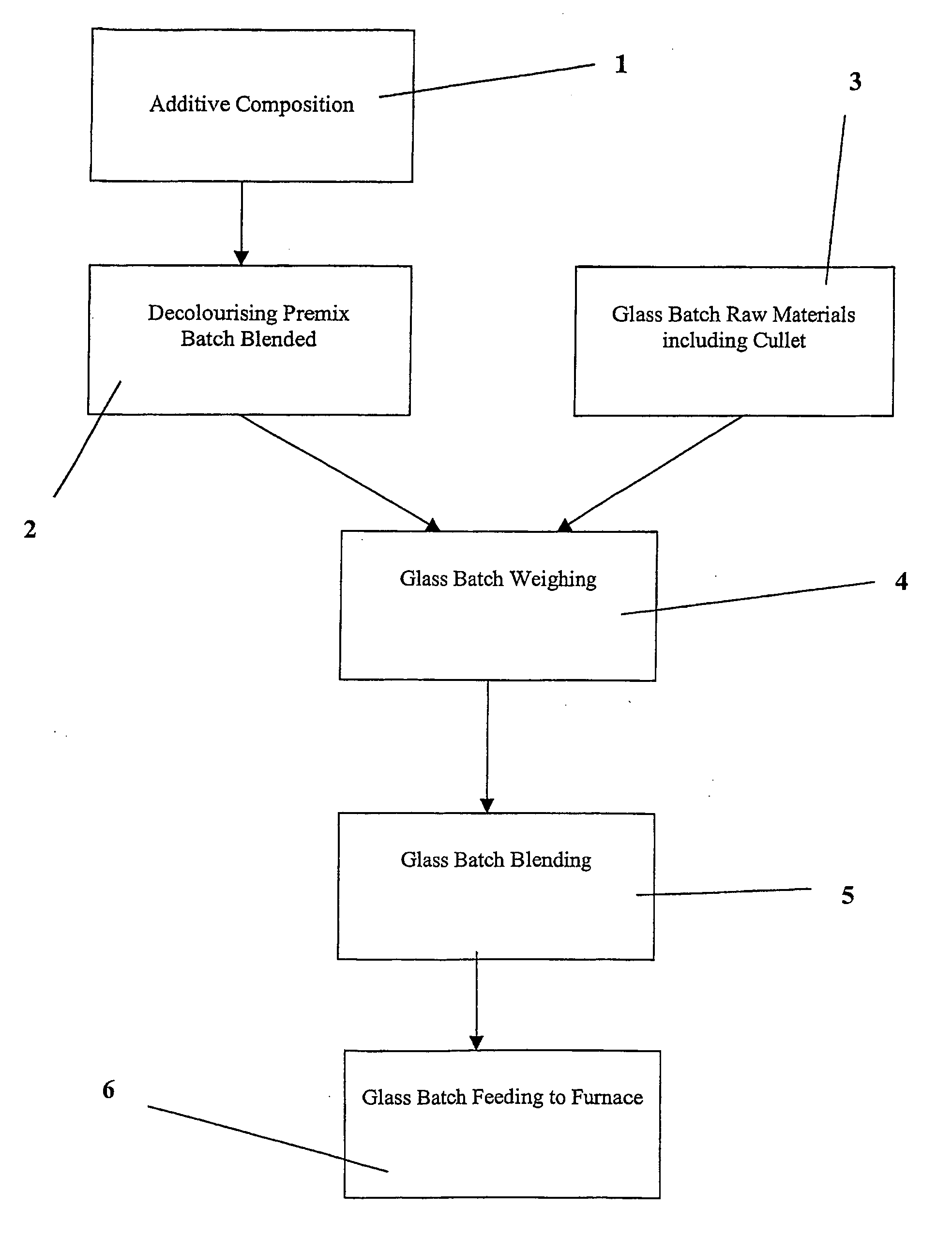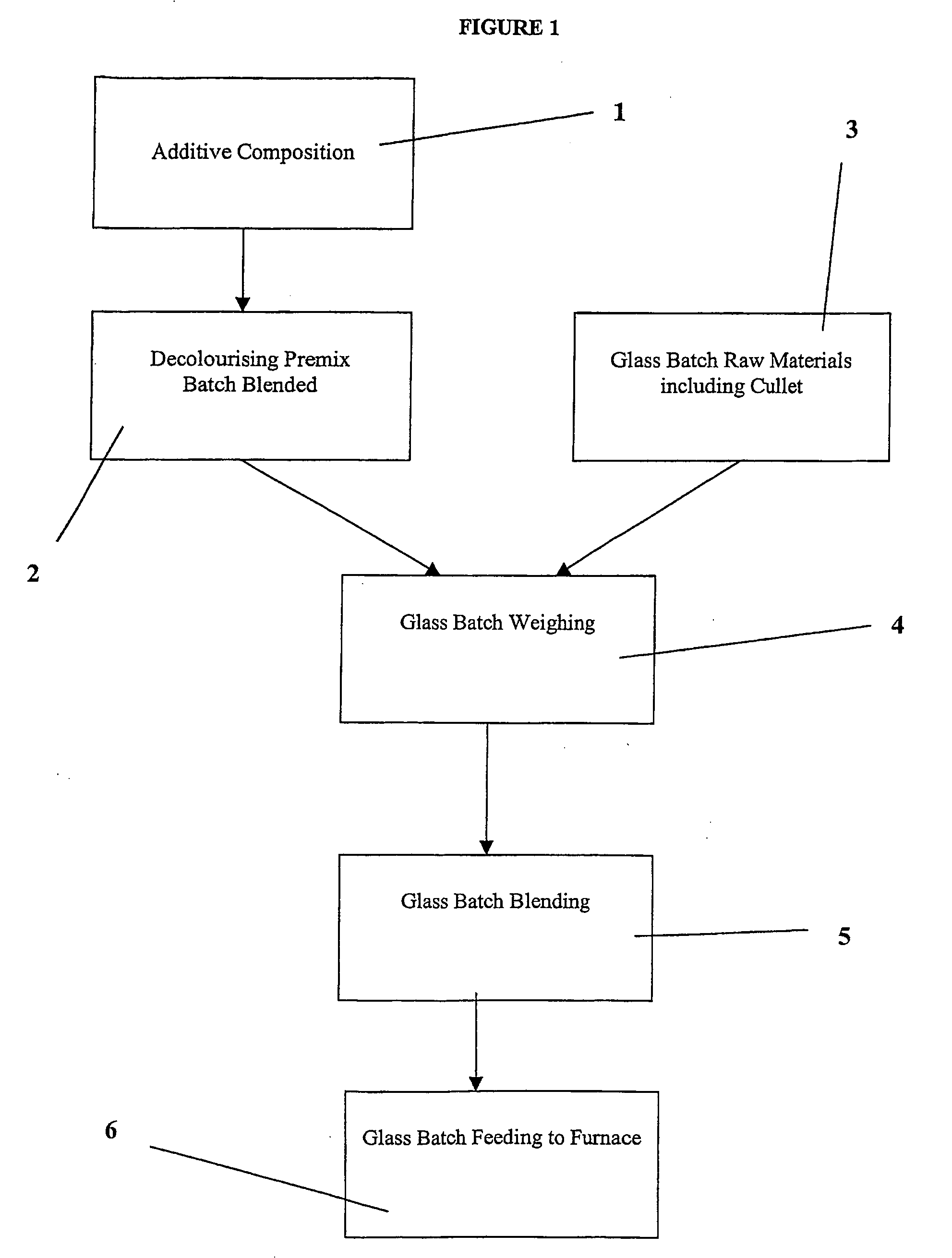Additives for the manufacture of glass
a technology of additives and glass, applied in glass making apparatus, glass furnace apparatus, charging furnace, etc., can solve the problems of increasing the cost of raw materials in glass manufacture, essentially losing from glass melt, and additives may also be lost from the process
- Summary
- Abstract
- Description
- Claims
- Application Information
AI Technical Summary
Problems solved by technology
Method used
Image
Examples
example 1
[0079] Preparation Zinc Selenite Additive Composition
[0080] A mixture of Polysorbate 20 (Tween 20®) 1 part was dispersed in polyethyleneglycol 300 10 parts to form a surfactant composition. Calcium carbonate particulate carrier of carbonaceous calcium carbonate of nominal particle size of 2 mm, 98.5 wt % CaCO3, and less than 0.09 wt % Fe as Fe2O3 (Trucal 6® supplied by Tilcon Ltd) (36.76 g) was added to a glass beaker. The surfactant composition (1 g) was added to the calcium carbonate in the beaker with stirring until an even liquid mixture was obtained. Then zinc selenite (41 wt % Se) (12 g) was added to the liquid mixture in stages with mixing until a uniform granule began to form. Finally the granule was finished by the drop wise addition of technical white oil (0.25 g) with mixing until a fully formed dry granule was produced.
[0081] The finished additive composition (granule) contained 9.84% w / w selenium.
example 2
[0082] Preparation of Cobalt II Oxide Additive Composition
[0083] A mixture of Polysorbate 20 (Tween 20®) 1 part was dispersed in polyethyleneglycol 300 10 parts to form a surfactant composition. Calcium carbonate particulate carrier (Trucal 6®) (40.50 g) was added to a glass beaker. The surfactant composition (1 g) was added to the calcium carbonate in the beaker with stirring until an even liquid mixture was obtained. Then cobalt U oxide (72 wt % Co) (7 g) was added to the liquid mixture in stages with mixing until a uniform black granule began to form. Finally the granule was finished by the drop wise addition of technical white oil (0.25 g) with mixing until a fully formed dry granule was produced. The finished additive composition (granule) contained 10% w / w cobalt.
example 3
[0084] Preparation of Se 1% Formulation
[0085] The following ingredients and process were utilised to manufacture the additive
CONTENT IN FINISHEDINGREDIENTPRODUCT % W / WSodium selenite (min. 99.0%)2.272Poly ethylene glycol 3002.008Polyoxyethylene 20 sorbitan0.201monolaurateAmorphous precipitated silica0.291Calcium carbonate granule95.228
[0086] The method for 1000 kg batch included the following steps.
[0087] In a horizontal ribbon blade solids mixer: [0088] 1. Switch on the mixer. [0089] 2. Add approximately half of the required calcium carbonate. [0090] 3. Add the sodium selenite. [0091] 4. Mix for 5 minutes. [0092] 5. Add the remaining calcium carbonate granule. [0093] 6. Mix for 5 minutes. [0094] 7. Spray the liquid mixture. [0095] 8. Mix for 5 minutes. [0096] 9. Add the silica [0097] 10. Mix for 3 minutes [0098] Discharge the mixer.
PUM
| Property | Measurement | Unit |
|---|---|---|
| particle size | aaaaa | aaaaa |
| particle size | aaaaa | aaaaa |
| particle size | aaaaa | aaaaa |
Abstract
Description
Claims
Application Information
 Login to View More
Login to View More - R&D
- Intellectual Property
- Life Sciences
- Materials
- Tech Scout
- Unparalleled Data Quality
- Higher Quality Content
- 60% Fewer Hallucinations
Browse by: Latest US Patents, China's latest patents, Technical Efficacy Thesaurus, Application Domain, Technology Topic, Popular Technical Reports.
© 2025 PatSnap. All rights reserved.Legal|Privacy policy|Modern Slavery Act Transparency Statement|Sitemap|About US| Contact US: help@patsnap.com


